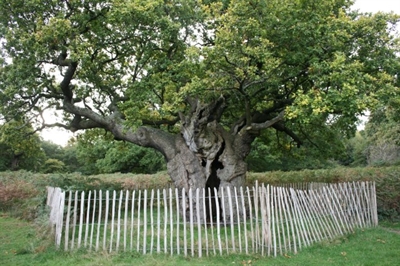The Richmond Park Royal Oak
There are around 1,300 veteran trees in Richmond Park recorded on the Ancient Tree Inventory, and around 320 of these are ancient. One of the most impressive of these is the Royal Oak, which can be found near Pen Ponds and is estimated to be around 750 years old. With its hollow trunk, which is wonderfully gnarled and squat, the tree used to be a popular place for children to play, as they could squeeze into the tree through a split down the centre.
The tree has now been fenced off to restrict access and this provides a welcome measure of protection. The veteran trees in Richmond Park are vulnerable to a number of threats, including fire caused by the use of disposable barbecues at the base of trees, and a number of trees have been badly damaged over the years. Compaction of the soil due to high visitor pressure is also a threat and the fencing helps to protect the root zone (although the Ancient Tree Forum’s general advice – see below – is that larger Root Protection Zones may be necessary depending on local conditions).
The Royal Oak has huge biodiversity value, with its decaying wood in the crown, hollowing, and nooks and crannies. Richmond Park is a National Nature Reserve, and London’s largest Site of Special Scientific Interest. Over 1,350 species of beetle have been recorded here, and many depend on the decaying wood found in veteran trees. Stag beetle larvae feed on decaying timber and need to be left undisturbed for up to seven years before they pupate and emerge as adults.
Since Richmond Park was first enclosed as a royal hunting park by King Charles I in 1637, herds of deer have roamed free here. Traditionally the Royal Oak, like many of the other trees in the park, would have been pollarded to produce straight, tall branches for timber, and to protect the foliage from browsing deer. The grazing deer have, over the centuries, stopped the grassy areas from turning into woods, and therefore allowed trees like the Royal Oak to grow and mature in wide open spaces, develop full canopies, and become ancient.
Information courtesy of The Ancient Tree Forum.
Royal Oak photo by Hannah Solloway.
The Ancient Tree Forum champions the biological, cultural and heritage value of Britain’s ancient and veteran trees, and provides advice on their value and management at www.ancienttreeforum.co.uk. Guidance on Root Protection Areas can be found in ‘Ancient and other veteran trees: Further guidance on management’ which can be bought or downloaded from the website.


